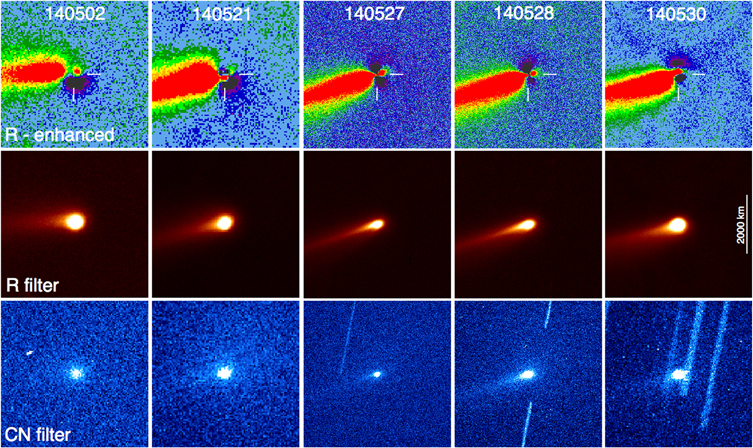
Lowell Observatory’s Dave Schleicher and colleague Matthew Knight have detected the least active comet on record. Identified as Comet 209P/LINEAR, it appears to be well on its way to becoming an inert—essentially dead—object, supporting a theory that some of the asteroids passing close to Earth may have started out as comets.
Comet 209P/LINEAR is one of 59 comets currently recognized as Near-Earth Objects (NEOs), defined as small solar system bodies that come within 1.3 astronomical units of the Sun (an astronomical unit is the average distance from Earth to the Sun, about 93 million miles). Of the more than 14,000 NEOs, the majority are asteroids.
209P/LINEAR orbits every 5.1 years but, due to its intrinsically faint appearance, remained unknown until 2004. That’s when scientists participating in the Lincoln Near-Earth Asteroid Research program (LINEAR) discovered it.
In 2014, Schleicher and Knight (formerly at Lowell and now at the University of Maryland) observed 209P/LINEAR as it made what was then the third-closest pass of Earth by a comet in the past two centuries. At such times, scientists can accurately measure the activity level of comets, which is triggered when the Sun’s warmth causes some of the ices—which are predominantly water ice—in the nucleus to sublimate (turn from a solid to a gas).
Schleicher and Knight used two Lowell Observatory telescopes for their research: the 4.3-meter Discovery Channel Telescope, with attached Large Monolithic Imager; and the 1.1-meter Hall Telescope, with the Kron photometer. They measured the comet’s production of gas and dust and studied properties of its nucleus and coma. Their measurement of the comet’s rate of water production was particularly intriguing, revealing the lowest of any intact comet in more than 35 years. From this they derived that the comet’s active surface measures only about 0.007 km2 in area, or about the size of a football field. This represents the smallest active portion of any known comet.
Combining this measurement with previously established estimates of 209P/LINEAR’s nucleus size (a diameter of about diameter of 3.1 kilometers, with a corresponding surface area of about 29 km2), the team determined that only about 0.2% of the comet’s surface is active. This led to the team’s conclusion that 209P/LINEAR is evolving to an inert state. Schleicher said, “In another hundred years it might not show any activity. And if it was discovered a thousand years from now it might even be misclassified as an asteroid.”
This conclusion is significant for the field of solar system studies and may help change how astronomers view these nearby celestial bodies. Schleicher said, “This supports the theory that some of these near-Earth asteroids probably have cometary origins.”
Results of the research were published in the October, 2016 issue of The Astronomical Journal and may be viewed at http://iopscience.iop.org/article/10.3847/0004-6256/152/4/89.